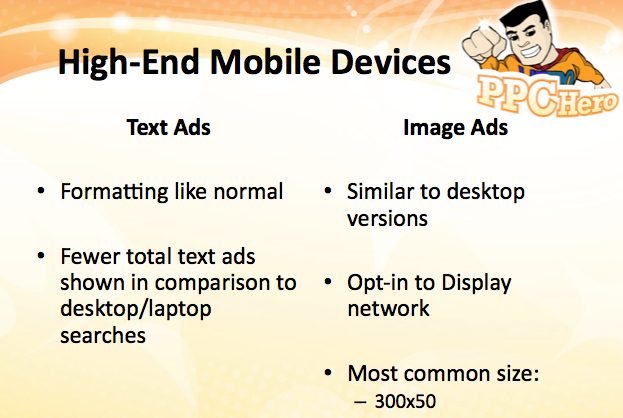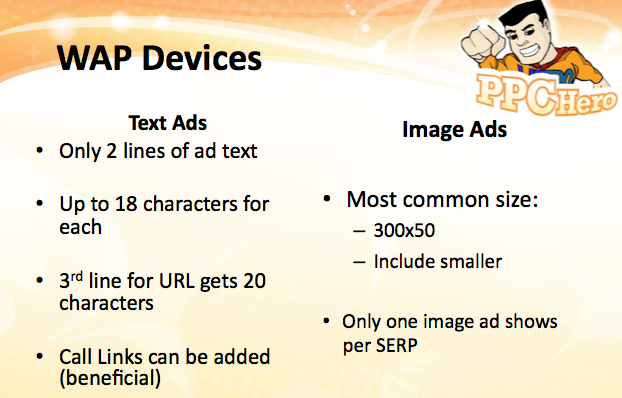Back in June of 2012 (which already seems like forever ago!) Amanda and I put together a video blog on how to approach mobile ad copy. Then, in October, Jeff presented a webinar with Wordstream about all things mobile. But those were both a while ago…and we’ve had some recent requests for a basics course on mobile ads. So why not have a beginning of the new year lesson?! Especially since mobile is still gaining momentum in the paid search industry and will only continue to increase in it’s importance to your overall web presence and marketing. Go. Time.
Why mobile?
Google has reported data that shows an incredible growth in mobile traffic to this point. For example, they tell us that mobile searches have increased 400% just since 2010. Further, they’ve shared statistics with us from their research that shows 79% of all smartphone users have used that device to shop and 74% purchase from their phone directly. This means the pool of potential customers that can be reached via mobile devices is going up, and they’re highly likely to convert if you approach them correctly. Many large brands have seen great success with optimizing mobile performance and that success can be replicated with an appropriate mobile strategy for your brand. So what’s that approach look like?
General Best Practices to Keep in Mind
- If possible, and as soon as possible if not immediately upon enabling mobile traffic, make sure all your mobile traffic is heading to a mobile-optimized (if not mobile-specific) landing page or mobile site. Website layouts vary by device, browser, etc., so having a site specifically for this traffic allows that site to be optimized outside of desktop/laptop, based on its own data. More importantly, users report that they will not react well to a poorly optimized mobile site, with 57% saying they would not recommend a brand with a bad mobile site and 40% would go to a competitor’s site if they have a bad experience. Don’t chance it!
- While it’s tempting to make as few segmentations for new campaigns in your PPC account, this is a situation where it’s nearly non-negotiable. Not only do you want your mobile traffic separated in to its own campaign, in a perfect world you should probably pull it out separate from tablet traffic, as well. Data shows that mobile campaigns that are split out on their own show an 11.5% increase in click-through rates, alongside a 29% increase in mobile clicks. The mobile segment simply does not function the same way as other devices, performance and formatting-wise. You don’t want to lump mobile in with any other devices in your targeting, or you end up mis-optimizing based on averaged data.
- Still along the lines of your mobile campaigns and how to target them, keep in mind location (more on this later) when enabling location extensions, etc. Make sure you’re showing the right localized information to the appropriate searchers. One of the most personally frustrating things for me as a searcher is when I’m looking for a pizza place in the town I’m in, and location extension come up for brick and mortar locations no where near where I am. Yes, it’s happened, but don’t let it happen to you!
- Once you’ve got mobile up and running, segmented and all, be patient. My general experience with mobile traffic is that performance is drastically different from laptop/desktop searches. Click costs vary (both higher and lower); conversion rates are usually lower, making costs per lead a bit high. However, I encourage you to do two things: Give it time and look at the whole picture before making a decision.
- When it comes to enabling mobile traffic, you need to give yourself some time to break in to the competition in the space. This is going to take longer than a week, more than likely, so don’t call it too soon that mobile “doesn’t work.”
- Additionally, mobile clicks that aren’t converting could be converting later through other devices after touching the brand via mobile. We’re talking attribution here, people, and it’s real. Someone could familiarize themselves with your brand on the go, and then come back once stationary to convert. Be wary of completely cutting a segment, and do the due diligence research before you decide for sure.
Ad Formatting & Optimization
Back when mobile was first introduced as a device to target through PPC, ad formatting and much of the functionality of mobile ads was similar to desktop/laptop formats. As the segment has grown, its earned it’s own set of rules and formats to be followed. When looking at your mobile ads, it’s important to consider the differences in these searchers compared to other devices and format/write/optimize those ads accordingly.
Mobile devices can be split in to 2 buckets: high-end and WAP. The following two screenshots show the formatting differences between the two:
As you can see, the WAP device ads are the ones that have the most difference in terms of formatting your text ads. However, even the high-end devices have some limitations when it comes to total ads that can show per page, etc.
Some additional ideas for improving your mobile ad text for the very specific searcher segment are:
- Provide a click to call option in your mobile ads. The click to call option allows your customer to reach you now and some customers are more comfortable with that option than continuing to search on their device or checkout/convert. Google reports click to call ads get 6-8% increases in average click-through rates, so you can certainly help your cause by allowing this option for your customers.
- Likewise, click to download has been a highly successful feature for mobile device ads. This is especially true if your brand has an app with additional information or features that can be tapped by your customer, downloadable through an ad click.
- Implement ad extensions for mobile, as they assist (see two bullets above) in increasing click-through rates for your mobile segment. Location extensions, sitelinks, social extensions…test them all!
- Including an offer with your mobile ads can greatly increase the likelihood of some interaction with your brand from the searcher. They allow you to show additional information about a special or offer you’re running without using up ad text space. Searchers can then store that offer to use later in-store.
- Link up your mobile ads with your seller ratings to gain customer buy-in, as they can see your performance based on user ratings through previous experiences. Research has shown some accounts see a click-through rate increase of 7.5% when seller ratings are enabled. Be cautious and aware of your situation, however. If you don’t have solid seller ratings to pull in, you may want to steer clear of this option until you get your customer service on target.
Whew! Hopefully all that information gives you a better idea of not only why you should/need to be targeting mobile devices, but also how to go about implementing them in a way that leads to the highest return for your ad spend. Let us know about your experiences with mobile! Have you had great success or failure with mobile targeting? What did you learn? Have you seen any recent or drastic changes in performance for this segment? Share your ideas, thoughts and experiences in the comments section below…and of course let us know if you have any questions!






